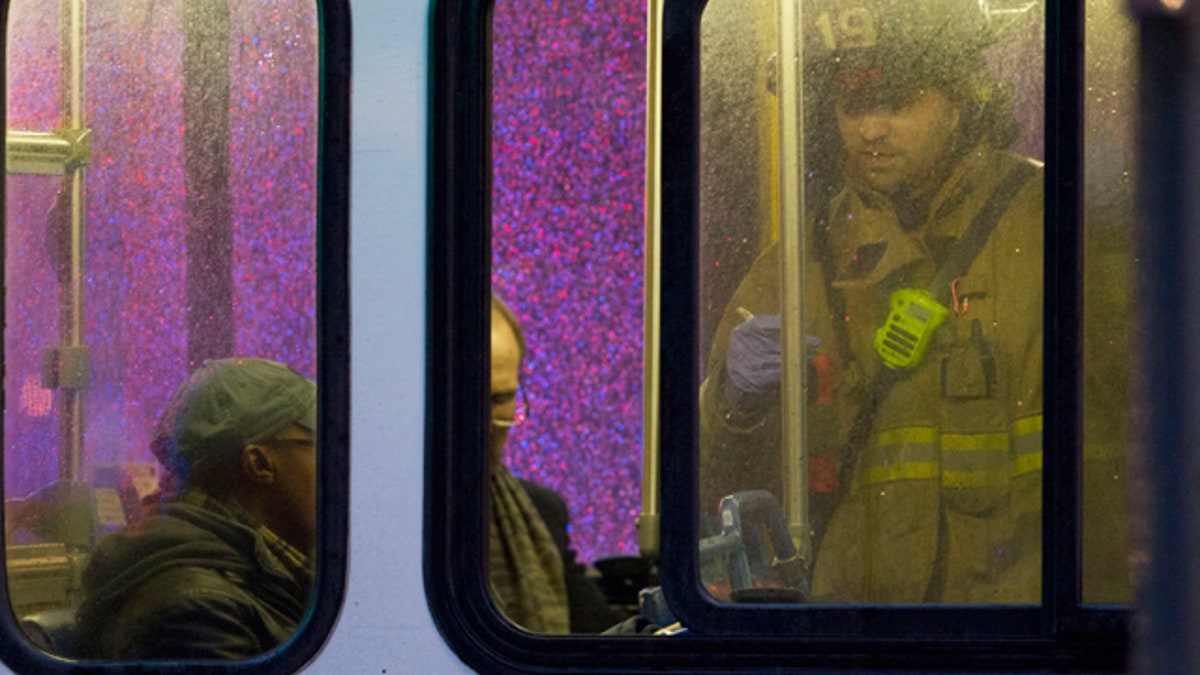
FILE - In this Jan. 12, 2015, file photo, a firefighter attends people on a bus to assess triage needs after people were evacuated from a smoke-filled Metro subway tunnel in Washington. One woman died and more than 80 others were sickened by smoke after an electrical malfunction in January caused a train to fill with smoke while it stopped in a tunnel in downtown Washington. (AP Photo/Jacquelyn Martin, File)
The operator of a Washington D.C. Metro subway train told investigators that he was ordered to remain in a smoke-filled tunnel as passengers coughed and choked on fumes that killed one rider and sickened more than 80 others, according to documents released Tuesday.
James Curley told National Transportation Safety Board (NTSB) investigators that he heard "yelling, screaming, kicking and banging on the glass doors" as the cars filled with smoke during the afternoon rush hour Jan. 12. The operator said the Metro transit agency's command center was unable to clear another train from the platform to allow him to return.
"I was going back and forth with them saying, 'Central, be advised I got people on the train they're saying they can't breathe, they're coughing, they're vomiting, I need to get back to the platform, I need to get back to the platform,'" Curley said. "And they just kept telling me, stand by, stand by."
Other interview transcripts and testimony from Tuesday's hearing revealed poor communication between Metro officials at the command center and the train operators and transit police officers inside the station. There was also friction between Metro officials and firefighters, transcripts showed.
While the staff at the command center was trying to figure out a way to move the stranded train back to the platform, the L'Enfant Plaza station was filling with smoke and police officers were ordering everyone to evacuate, including the operator of the second train. Once passengers started evacuating, power was cut to the third rail and it was impossible to move the trains, Metro officials said.
"We immediately de-energized power throughout the entire area for the safety of the customers," said Marcel Malloy, assistant superintendent at the command center. "And at that time I think we lost it. We had no more control of the railroad."
Curley, who has worked for the transit agency for almost 15 years, described the passengers as increasingly desperate. Despite his instructions not to open the train car doors, he said some people evacuated on their own and started walking away from the train.
Many passengers who left the train on their own were able to get to safety long before firefighters arrived, more than 30 minutes after the train stopped in the tunnel.
The operator of the second train that stopped on the platform, Connie Conner, told investigators that she was told to look out for smoke but wasn't told to stop the train or back up. However, a radio operator at the command center told investigators that she twice ordered Conner to stop her train as soon as Curley informed her he had stopped in the tunnel.
Meanwhile, above ground, Metro police and District of Columbia firefighters also failed to collaborate, according to transcripts and testimony. At one point, a police commander tried to talk to a fire department battalion chief who was coordinating the response, but the chief rolled up the window to his vehicle and drove away, officials said.
Other documents released Tuesday showed that the ventilation systems in Metro's tunnels — which the NTSB has already said were not working properly on the day of the malfunction — were never designed to remove smoke "from even a moderate fire." Metro conducted two studies in the 1980s that concluded the ventilation systems needed to be renovated, but the work was never done, the documents showed.
Metro officials also said during the hearing that the system's tunnels have no smoke detectors, and there is no plan to install them.
NTSB documents also revealed that there were repeated water leaks near the site of the electrical malfunction. The board has ordered Metro to repair or replace components designed to protect the electrified third rail from water or other contaminants.
The cause of the malfunction has not been determined, and the NTSB is not expected to release a final report with recommendations until next year.
The Associated Press contributed to this report.

